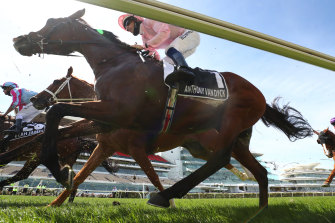Champion horse was lame before fatal 2020 Melbourne Cup run
The highest-profile international horse to die at an Australian racetrack, English Derby winner Anthony Van Dyck, was lame a month before he broke down in the Melbourne Cup, raising questions about why he was allowed to run.
A report by Racing Victoria into the death found the Aidan O’Brien-trained stallion was administered a nerve block injection on October 9. Despite concerns about the horse’s fitness, CT scans were not done to determine the extent of the horse’s injuries.
Anthony Van Dyck was administered a nerve block before his run in the Caulfield Cup.Credit:Getty Images
A nerve block is a type of anaesthesia commonly used by vets when a horse is lame to determine where it is sore. A CT scan is a more advanced diagnostic tool used to identify the nature and severity of an injury.
A CT imaging machine was available. One was installed at the University of Melbourne’s U-Vet Werribee Equine Centre, about five kilometres from the facility where the horse was quarantined, after The Cliffsofmoher – another O’Brien Cup fancy – was euthanised after being injured in the 2018 Melbourne Cup.
Anthony Van Dyck is the seventh horse – all internationals – to die in the Melbourne Cup in as many years. The high fatality rate, which statistically makes the two-mile handicap one of the world’s deadliest races, has pitched the event into crisis and forced Racing Victoria to re-examine how international horses are managed throughout the spring carnival.
The horse was the second O’Brien runner to be euthanised after the Cup and one of four horses trained by Mr O’Brien to have died during the past three spring carnivals. Mr O’Brien did not attend last year’s Melbourne Cup due to COVID-19 restrictions and could not be reached for comment.
2014 Melbourne Cup race favourite Admire Rakti died in its stalls in full view of the racegoers.Credit:Eddie Jim
The necropsy of Anthony Van Dyck confirmed the horse shattered his left fetlock in the closing stages of the Melbourne Cup. It supported the decision to euthanise him shortly after the race.
The nerve block was administered to another part of the horse’s body. The report draws no conclusions about whether the horse’s run at Caulfield on October 17 – a fast-finishing second place which elevated him to one of the pre-race favourites for the Melbourne Cup – contributed to the fetlock injury.
Melbourne Equine Veterinary Group partner Rob McInnes said nerve blocks were regularly used on racehorses, particularly in cases where a horse was lame but showed no obvious signs of injury such as tendon heat or swelling.
He said the administration of a nerve block on Anthony Van Dyck suggested due diligence on the part of the horse’s treating vet, John Russell.
“These horses are rarely completely sound,” Dr McInnes said. “It is the responsibility of the trainer, the vet and racing authorities to determine the significance of any lameness.”
Dr McInnes said that, although advanced diagnostic tools such as CT scans were not always necessary to determine the extent of a horse’s injury, their use before the Melbourne Cup would improve public confidence in the race.
Start your day informed
Our Morning Edition newsletter is a curated guide to the most important and interesting stories, analysis and insights. Sign up to The Sydney Morning Herald’s newsletter here, The Age’s here, Brisbane Times’ here, and WAtoday’s here.
Most Viewed in Sport
From our partners
Source: Read Full Article


